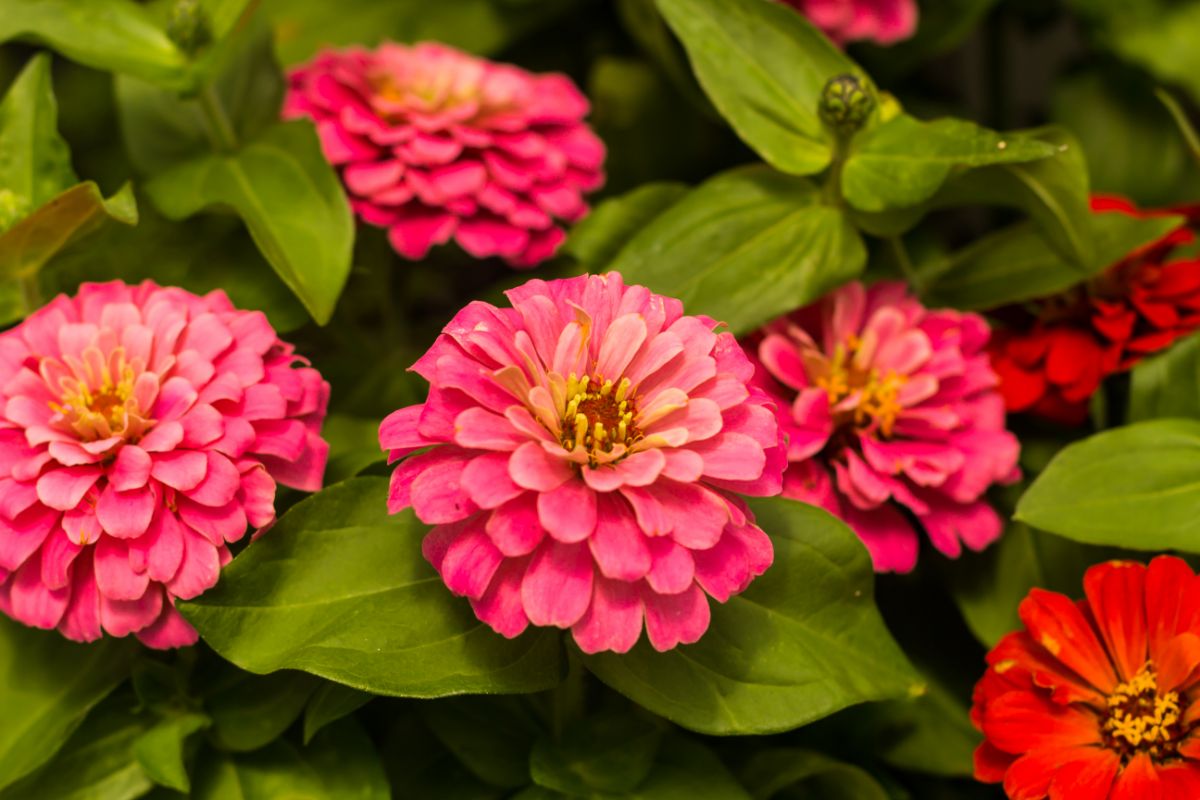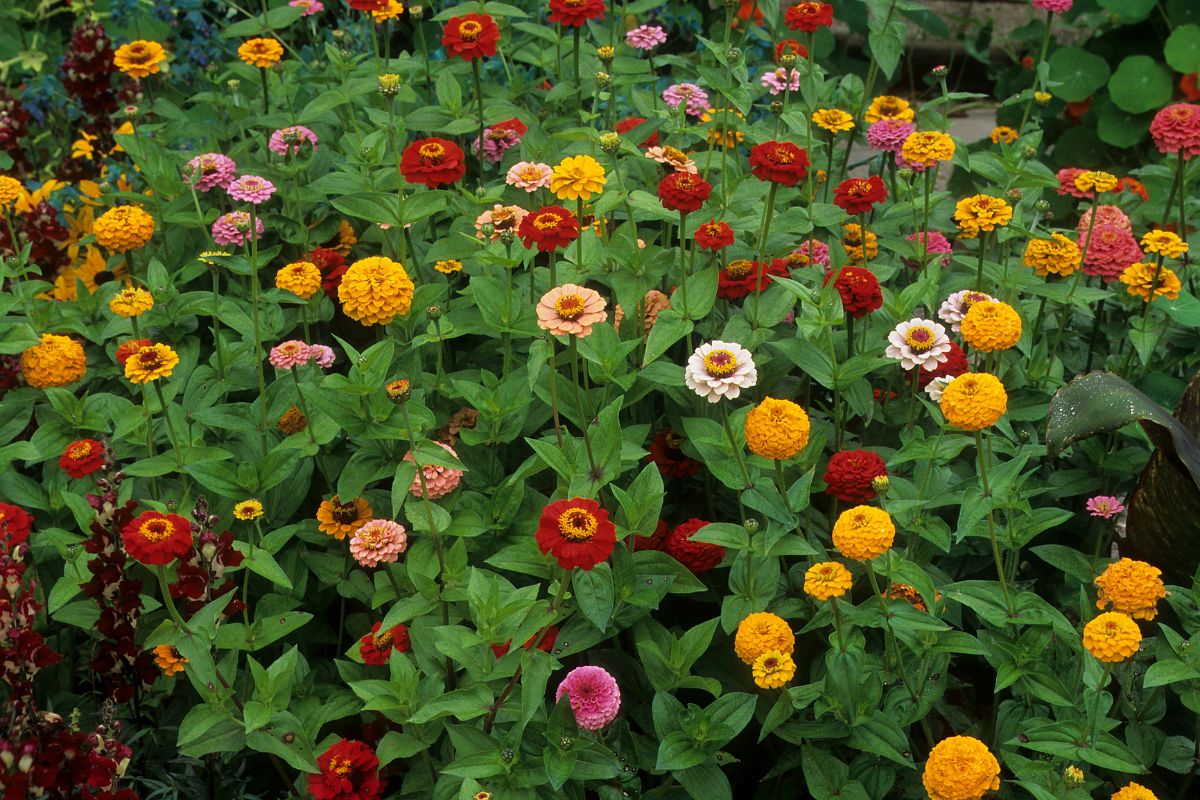If you’re thinking of planting a different flower in your backyard, you can’t go wrong with the zinnia!

Zinnias produce large, attractive blooms that resist drought and heat well. They also attract pollinators have a long flowering time, and are very easy to grow.
Zinnias are part of the Asteraceae group and are a common sight among many home gardens.
If you’re considering bringing your garden to life with zinnia flowers, you’ll probably want the flowers to bloom for as long as they can.
The question here is will your zinnias bloom for a single year, or will they keep growing back annually?
You’ll find out the answer to this question in this post, going over whether zinnias are perennials or annuals, as well as tips to keep zinnia flowers blooming for longer.
Keep reading to discover whether zinnias are perennials or annuals!
Are Zinnias Perennials Or Annuals
The answer varies between different species, but zinnias are generally thought to be annuals in the gardening industry.
Some types of zinnias are perennials, which we’ll go into in more detail later.
However, these varieties aren’t generally sold by customary seed brands or plant nurseries, so they are mainly found in the wild.
Perennials And Annuals
Annual plants are different from perennial plants. As the name suggests, annual plants will finish their life cycle in a year. The plant will germinate, mature, flower, and set seed, typically between spring and fall.
This may vary based on the type of plant and your location.
Perennial plants finish their life cycle over several years. Some live longer, while others have a shorter life cycle. In most cases, these are slow-growing plants that may have woody growth, though there may be exceptions.
The foliage and stems that grow above the earth may cease a little during winter. The tubers, bulbs, and roots below the earth still live, performing as the plant’s storage organs.
These keep the energy for the next spring, as the plants stop being dormant to start growing once more.
Perennial plants may need a few years to set hold, but after they are established, they will keep blooming each year.
Some may even bloom during the first planting year, though they’ll grow bigger and stronger as they mature.
Typically speaking, there are initial indications that zinnias won’t live over a year, but a lot of them do, living through an impressive lifespan.
Treating Plants As Annuals
Occasionally, you may find gardeners that like to treat rapidly growing perennials like annuals. Instead of letting the plant live on for over two years, they can dispose of it or clear the space for future plants.
This may be necessary when flowering requires a lot of the plant’s energy, so it will need several years to recover.
This is visible when commercial flower growers produce tulips. Tulips are perennial plants. The foliage will grow from bulbs every year, generating an attractive flower.
You can let the foliage die back naturally, as new flowers will develop the next year.
Commercial cut flower production involves growers collecting flower stalks so they are as long as possible for the last user, which is normally the florist.
This harvesting method removes the plant’s leaves. Leaves are necessary for photosynthesis, so they are necessary to give the plant its energy.
Foliage may grow from the tulip bulb the year following the tulip flower harvest, but flowers won’t be visible for one to two years.
Creating big and attractive flowers requires lots of energy, so it will need to regain energy to flower once more.
Flower growers will regularly treat the tulips as though they were annuals. They will buy new bulbs each year instead of worrying if the tulips will or won’t flower the next year.
Gardeners may also treat perennial plants like annuals when the plant may struggle during winter, within a certain hardiness zone. Zinnias are primarily native to Mexico and the Southern United States.
Perennial zinnias may not survive in winter when growing in areas north of these locations.
As a result, the zinnias would need to seed once more in spring, except when the gardener arranges to take plants inside during winter.
Tips To Keep Zinnias Flowering For Longer
Zinnais aren’t perennials, but there are things you can do to enjoy a large number of their flowers during the growing season.
Here are some tips to keep the plants blooming for a long time:
- Deadhead the zinnias so they flower for the whole summer. After the flowers wither, pop or cut off their heads. This will increase flowering time and the number of blooms.
- Plant several groups of zinnias throughout the general gardening season. Succession planting the flowers will give you a larger display of blooms and colors.
- Save some zinnia seeds for the following year. You can usually plant zinnia seeds outside near the final spring frost. After you scatter the seeds and score them inside the soil, nature should handle the rest.
Common Types Of Zinnia Plants
Now that you know some more about zinnias, here are some common zinnia types that look great in home gardens.
Annual Zinnia Species
Annual zinnia species are the most common ones seen in home gardens.
Annual zinnias are usually seen in vegetable gardens to lure in pollinators, on the sides of landscape beds to deliver groundcover, or as cut flowers to dress up bouquets.
Zinnia Elegans
This is the most common type of zinnia. If you’ve seen zinnias before, they were probably part of the group Z. elegans. This annual variety generates one to three-foot-tall plants with big flowers.
Here are some types of zinnias that are part of this species.
Benary’s Giant: This is the most commonly grown type. It develops plentiful four to five-inch flowers that stand up to mildew well. There are 13 different shades within this series.
Uproar Rose: This type is a well-branching plant with big, attractive, rose-like flowers.
Queen: This series has been a popular cut flower choice over the past few years. It comes in warmer colors of orange, blush, and rose, which lighten slightly into lime green blooms.
Zowie!: These produce interesting flowers with petals of two colors: magenta and gold.
Oklahoma: These produce attractive, small flowers that are just around two inches wide. These are a lot smaller compared to the bigger Benary’s Giant, but they still deliver impressive bold colors.
Zinnia Haageana
This zinnia species matures to two feet in height, growing flowers that reach one to two inches wide. A lot of these flowers come in two different colors.
Here are some types of zinnias that are part of this species.
Aztec Sunset: This series comes in colors that run from orange, yellow, and red, as well as an attractive two-toned maroon and orange.
Soleado: This series has bold, cheery shades of yellow and orange. They also have a dark mahogany circle around their core.
Zinnia Angustifolia
This species is a low-growing plant that’s normally used in containers, borders, and hanging baskets. Some dwarf types can be as short as six inches, but others can grow up to three feet in height.
Star: As the name suggests, this plant produces blooms that resemble stars. They are known for standing up to mildew well.
Crystal: A single-petaled series that produces yellow, orange, and white blooms. This can grow up to ten inches in height.
Perennial Zinnias

The group outlined below are typically found forming in the wild, several of which are native to Mexico and the United States.
These varieties aren’t normally available to buy from plant nurseries, but occasionally, native plant seed businesses may offer their seeds for sale.
You can also gather the seeds yourself, but remember to follow your state’s regulations concerning seed collection.
Zinnia Grandiflora
This perennial plant goes by other names, including ‘golden eye’, ‘wild zinnia’, and ‘Rocky Mountain zinnia’. WIld zinnias develop between four and eight inches in height.
They circulate through rhizomes, performing as a groundcover.
These blooms are normally yellow and do best on rugged terrain in sunny, warm, locations. You can also propagate the plant with cuttings or division.
Zinnia Acerosa
This variety is a perennial up to USDA zone 6. It has herbaceous stalks that turn woody as the plant gets older. They have white, creamy petals that have a bold yellow middle.
Other names for this series are shrubby zinnia and desert zinnia. The plant is low-growing and has green-silver stalks and leaves. You can find it growing in plains, prairies, meadows, and savannas at greater altitudes.
Zinnia Anomala
Otherwise known by the name ‘shortray zinnia’, zinnia anomala will live as a perennial until USDA zone 8.
It produces five to eight noticeably stocky petals, or will grow no petals whatsoever. Zinnia anomala is also known as a sub-shrub, which is a low-growing, woody-based perennial.
The Bottom Line
Zinnias are annual plants that will finish their life cycle in a year. It’s best to plant them at the beginning of the season so they bloom for the entire growing season.
No matter which type of zinnia you grow in your backyard, their bold petals are sure to brighten up your entire garden. We hope you try growing these gorgeous plants at home for yourself!
- Interesting Flowers That Start With A - July 21, 2023
- Interesting Flowers Beginning With H - July 21, 2023
- 14 Fascinating Flowers That Begin With C - July 20, 2023
